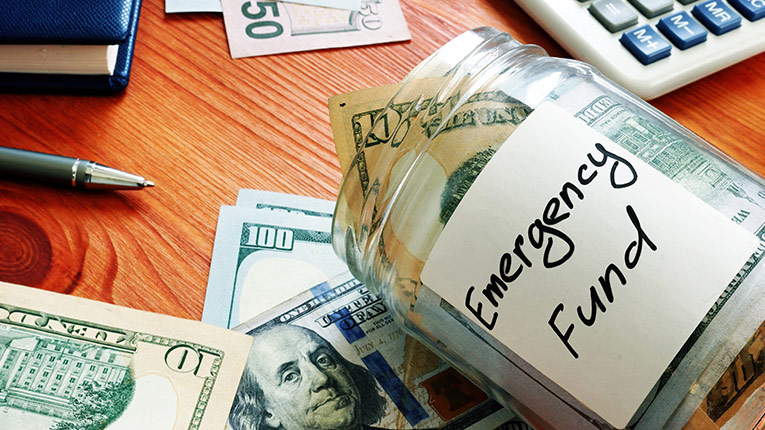Emergency fund: Why you need one & how to start saving

Unplanned expenses happen from time to time—like a broken appliance, surprise medical bill, or loss of income. Having a dedicated emergency fund helps provide reassurance you’ll be able to cover some (or all) of the cost when the unexpected happens. Let’s take a closer look at some of the common types of emergency expenses, how much you need to save, and how to build an emergency fund.
What is an emergency fund?
An emergency fund is typically a dedicated savings account set up to cover unplanned expenses and financial emergencies. Emergency savings differ from other types of savings you may have set aside when planning for expenses like leisure travel, holiday gifts, a down payment for a home or car, or other financial goals.[1]
Some examples of unforeseen expenses include:
Unexpected medical bills
Vehicle repairs to keep your car on the road
Urgent home repairs, like a leaky roof
Appliance repairs or replacement
Emergency veterinary bills
Unemployment or reduced wages
Natural disasters
A global health crisis
Why you need an emergency fund
Remember, emergency funds should only be tapped to cover unexpected expenses that aren’t part of your routine monthly budget spending or other savings goals. The types of situations you can cover with your emergency fund depend on how much you have saved—but remember, every little bit counts.[1]
If you’re wondering what’s the goal of an emergency fund, here are a few reasons why you can benefit from having money set aside for a rainy day.
Pay for minor unplanned costs. An emergency fund helps you cover small unexpected expenses, like fixing a broken washing machine or taking your dog to the vet.
Protect against loss of income. If you’re out of work for an extended time or lose your job, your emergency fund helps pay for essential expenses like rent, utilities, and groceries.
Avoid extra debt. Without an emergency fund, even a small financial setback could turn into debt that’s hard to pay off and have a lasting impact on your financial outlook. This is especially true if you need to use an emergency loan, high-interest credit cards or tap other savings, like retirement accounts, to cover an unplanned cost.
Gain peace of mind. Having a nest egg set aside for unplanned expenses helps ease the financial stress in the event of an emergency, allowing you to put your focus on dealing with the situation instead of worrying how you’ll cover the cost.
What’s a good amount to have in an emergency fund?
Experts generally recommend saving at least three to six months’ worth of expenses. However, the amount of money needed in your emergency fund varies widely depending on factors like your income level, the rate at which you can save money, and your other financial obligations and goals.
For example if you have a lot of high-interest debt, you may be more focused on paying that down instead of saving. However, even if you’re paying off debt, it’s still a good idea to put some cash toward an emergency fund.[2]
To determine how much you need to save, it’s important to consider how you’d pay for a small emergency—like a $500 vet bill, for example—as well as covering your essential expenses in the event of job loss. Also think about your personal financial situation, including your income, bills, and who you’re financially responsible for.
Are you the sole earner with dependents? Do you share expenses with a partner and have no children? Is your income steady, or are you a freelancer with a fluctuating cash flow? Don’t forget to think about your debt. Do you have lots of credit card debt, a car payment, student loan, or other obligations? It’s also important to consider your essential expenses like rent or mortgage, groceries, utilities, and insurance premiums.[1]
Here’s when to save 3 months’ worth of expenses
An emergency fund with three months’ worth of expenses can help you financially navigate a major emergency, like being out of work after a car accident. While it won’t cushion you for the long haul, it can help cover your essential bills while you get back on your feet. If you share expenses with a partner, three months might also be a strong savings goal, since you’ll have another income source to lean on.[2]
Here’s when to save 6 months’ worth of expenses
Consider saving six months’ worth of expenses to get through a major emergency, like getting laid off. This is especially important if you’re the sole earner or don’t have any other financial resources to tap into. While saving six months of expenses might seem overwhelming, it’s okay to start small. Save up for one month, then two, and so on. Before you know it, you might be surprised to see how much you’ve saved.[2]
How to start building your emergency fund
If you’re not sure how to get started building your emergency fund, here are a few strategies to begin saving.
Set a goal
Start by setting a small savings goal you can easily reach, and increase your goal amount as you progress. For example, what was the last unplanned expense you had difficulty paying? If paying a $300 dental bill was a struggle before, then set an initial emergency fund goal of $300. Once you reach that goal, set a bigger goal, and so on.
Some banks let you create savings “buckets,” which can come in handy if you want to set separate savings goals for different kinds of emergencies, like medical expenses, car repairs, or veterinary fees.[1]
Build saving into your budget
Examine your current budget and spending habits to find areas where you can cut back, and put that money toward your emergency fund. Consider forgoing some “extras,” like pricey entertainment tickets or restaurant visits and streaming services. If you don’t have a budget, now is a great time to create one.[1]
Automate your savings
Decide on an amount you can afford to have automatically transferred to a savings account on a regular basis. For example, saving just $25 a week adds up to $1,200 a year. Typically you can set up automatic transfers between two bank accounts, like a checking and high-yield savings.
If you get paid by direct deposit, ask your employer to split up your paycheck between two accounts. Freelancers can try designating a small percentage of every client payment to an emergency fund.[1]
Use a financial windfall
Whenever you come into extra money, like a tax refund, stimulus payment, or cash for a birthday gift, put it into your emergency fund. Similarly, if you get a raise or earn a bonus, try to keep living on your previous income and set the difference aside for a rainy day.[1]
Earn extra income
Starting a side job or gig—like selling items you no longer need or use, driving for a rideshare service, or working retail during the holidays—can all jump-start your emergency savings. If you’re a freelancer or have inconsistent income, instead of automating transfers (which may leave your checking account short of funds), you might try designating a certain percentage of every deposit—say, 5% or 10%—into your emergency fund.
Don’t spend your emergency cash
Remember, your emergency fund is supposed to be used for unexpected expenses and needs. For example, you’d use the fund to buy a new washing machine if yours breaks down, but not just because you want the latest model. It’s also important to replenish any funds you take out of the account. So, if you use $500 to buy that replacement washer, set a new goal to replace the $500 you used so you have it for the next emergency.
Where should you keep your emergency fund?
When choosing the type of account for your emergency funds, consider easy-to-access, interest-bearing savings or checking accounts. Generally, unless there are additional associated fees, the account should be separate from your existing accounts, such as a vacation savings account or a regular checking account used to pay your monthly bills.
Look for an account that lets you earn interest to help you build your savings faster. Good examples of emergency fund accounts are typically high-yield savings accounts or money market accounts that offer a higher annual percentage yield (APY) than regular savings accounts. A rewards checking account may be another good option for your emergency fund. These types of accounts are also usually easy to access if you need to make a quick withdrawal.
However, depending on your financial habits, it might be helpful if your emergency funds are a little bit harder to get to. To create some friction, consider establishing an account at a different bank than where you have your regular checking or savings accounts. Confirm how long it takes to transfer money from one bank to another in case you need to withdraw funds quickly.
Some accounts come with fees, a minimum opening deposit, or a monthly balance requirement. So be sure to check the fine print when comparing accounts. It’s also a good idea to look for insured financial institutions to keep your money safe.
Federally insured banks are covered by the Federal Deposit Insurance Corporation (FDIC), and federally insured credit unions are covered by the National Credit Union Administration (NCUA). This protection means your deposits are insured up to the maximum amount allowed, which is $250,000 per depositor, per ownership category at each institution.[3][4]
The bottom line
An emergency fund not only ensures you’ll be able to meet unanticipated financial needs, but it’s also one of the first essential steps you can take to start saving. Putting even a small amount aside for emergencies can help you recover more quickly and get back to meeting your financial goals that much faster.
Setting aside at least three to six months’ worth of essential living expenses is ideal, but if you’re on a tight budget, saving even just a few hundred dollars may be enough to cover smaller emergencies like a broken dishwasher.
Consumer Financial Protection Bureau. “An essential guide to building an emergency fund.”
CNBC. “3 to 6 months of savings might be ‘tried and true wisdom’ but this expert has advice if you’re living paycheck-to-paycheck.”
Federal Deposit Insurance Corporation. “Deposit insurance.”
National Credit Union Administration. “Frequently asked questions about share insurance.”




